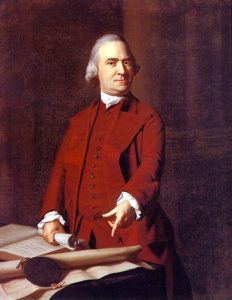Welcome to this article about Samuel Adams! Considered as one of the founding fathers of the United States of America, he was a famous revolutionary leader and statesman who played an important role in the American War for Independence. Join us as we take a look at the life and the works of this prominent politician.

Interesting Facts about Samuel Adams
1. Adams was one of the three out of twelve children who survived in his family.
Samuel Adams was born on September 16th, 1722 in Boston, Massachusetts. His father was Samuel Adams Sr. who owned a brewery in Boston, and his mother was Mary Adams. Adams Sr. was a church deacon as well. They had twelve children including Samuel, but this period of history had high infant mortality, so unfortunately only three of the children survived past their third birthday.
2. He had an interest in politics shaped by family events.
Adams studied at Boston Latin School and commenced his university studies at Harvard College. While his parents urged Adams to pursue his future in the church ministry, he was more interested in politics. Conflict in the family, especially with regards to a banking controversy of his father, urged Adams to seek for answers in the larger scale through government reforms and the like.
3. Adams moved across careers before entering politics.
After graduating from Harvard, Adams was unsure as to what his prospects were. He initially worked at a counting house for a few months. After this, he was employed by his father in the brewery and Adams Jr. worked in the production of malt for brewing beer. After Adams Sr. died in 1748, Adams Jr. took over managing his family. He went on to marrying Elizabeth Checkley and they had six children (of whom only two survived). Checkley had an untimely death in 1757 and Adams would marry Elizabeth Wells in 1764.
4. His distrust of the British government urged him to enter the office.
Adams entered his first office status in 1747 through the Boston Caucus. He served as a tax collector which would eventually end in a failure of sorts. In addition to this, the debacle over the new form of currency in the colonies left a strong sense of distrust of the British rule, according to Adams. He began seeking a more fitting place for his ideals and thus joined the Popular Party led by James Otis Jr., who would culture Adams into becoming a future political leader. By 1765, Adams had become a professional and was well-versed in politics and resistance.
5. He helped to form the Loyal Line:
Britain began to decide that the colonies in America were required to pay more for the war (which the colonists began). From 1765, the British government imposed taxes such as the Sugar Act and the American Revenue act as starter taxation. Adams was quick to raise his voice against this, stating that this was another act of unnecessary authority and that this was a violation of the colonists’ rights. When the parliament replaced the Sugar Act with the more controversial Stamp Act, Adams protested even more. This led to the formation of the Loyal Nine (a group of American patriots who opposed these taxes) which resulted in a series of riots by the colonists.
6. Adams was part of the Sons of Liberty.
Regardless of the protests by the Loyal Nine, the parliament further issued the Townsends Act of 1767 which taxed items such as lead, glass and tea. In response to this, Adams drafted the Massachusetts Circular Letter and together with the riots, this forced the British parliament to send British troops to Boston. Due to this, The Sons of Liberty were formed, which was an anonymous organization that fought to advance the rights of the colonists and fight the taxation of the British parliament. Further riots resulted in the Boston Massacre of 1770.
7. The Boston Tea Party occurred during his governance.
On the 10th of May 1773, the British parliament passed the Tea Act, a tax law which granted the East India Company added support and monopoly on tea trading. This meant that tea in Boston would be cheaper than other tea products in the market of Boston. This culminated in a crisis; by November 28th, the tea ships began to arrive in the Boston harbor. Although Adams tried to contain the protests, several demonstrators, some of whom were disguised as Native Americans, climbed aboard the ships and began to destroy the shipments by throwing the crates of tea into the harbor. This was met with a harsh reaction from the British government and would eventually lead to the American revolution.
8. He died with an accomplished but controversial legacy.
Prior to his death, Adams continued to stand with political affairs; he was a delegate of the Continental Congress and through this, he guided the congress towards the Declaration of Independence of 1776 amongst a range of other articles. After the American Revolution, he was elected as the Governor of Massachusetts. Adams passed away on October 2nd 1803 at the age of 81.
The legacy he left was considered controversial: on one hand, he is regarded as one of the founding fathers of America and a prominent leader the American revolution. On the other hand, he is seen as someone who spread his propaganda viciously and would incite mob riots and violence to fulfill his own goals (ahead of the country’s goals). Either way, these premises are debated by historians to this very day but we can conclude that modern day United States and its political culture would not have been as it is without the work of Samuel Adams.
I hope that these facts about Samuel Adams were helpful to you. If you want more facts about other historical people, visit historical people pages.
